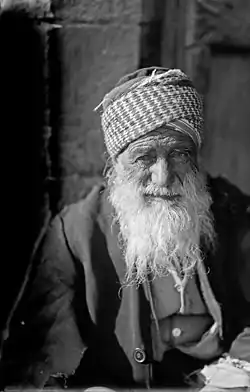Sudra (headdress)
Sudra (Aramaic: סודרא, Hebrew: סוּדָר) is a traditional ancient Jewish headdress, or what is also called a habit.

Etymology
The name sudra is Aramaic and is the word from which the Latin word sudarium, is derived from which means 'cloth' or 'handkerchief'.[1] However, according to the Babylonian Talmud, the word is a contraction of the phrase "Secrets are revealed to those who fear the Holy Name." [2]
History
The sudra is believed to be thousands of years old and referred to in the Bible. Ancient Hebrews wore a headgear that was similar to either a keffiyeh, turban or a stocking cap. There are many ways of tying the fabric to make these different designs.[3] The sudra has been mentioned directly and indirectly in ancient Jewish religious texts, including the Babylonian Talmud. Targum Ruth has interpreted different words in the Book of Ruth, such as mitpahat (הַמִּטְפַּחַת Ruth 3:15) mean the Sudra.[4] Removing the Sudra to let another hold it was also seen as a sign of symbolic trust during a monetary deal.[5] It may also have been used for the purposes of strangulation or torture.[6]
Style
In Jewish tradition, the sudra was a twisted scarf worn around the neck[7][8] There is also evidence of Jews wearing the sudra on their heads like a keffiyeh or turban in Tractate Berakhot, Tractate Kiddushin,[9] and Tractate Shabbat [10] in the Babylonian Talmud.[11] The Jastrow Dictionary, citing Rashi, claims the sudra was both wrapped around the head and wrapped around the shoulders, even extending down to the arms in some cases.[6]

The Shulchan Aruch Orach Chaim gives a specific exemption for a sudra in regards to tzitzit, despite the fact it is a four cornered garment.[12] There, he talks about the appropriation of the Sudra by Arabs into what he says is commonly known as the 'shid.' He describes the Sephardi custom as being over the shoulders like a scarf and the Remo states that Ashkenazi custom as covering more of the body when worn in its scarf form, comparing it to coiling round the body like an Egyptian Snake and noting that some wear it like what he calls the 'Kaftanis' of the Tatars when worn on the head.[13] This may be the origin of the shrtreimel for when cloth was exchanged for fur.[14]
Decline
Amongst Ashkenazi Jewry, the Sudra quickly fell out of favour over time in favour of the streimel and the spodik, which were possibly adopted from their non-Jewish neighbors in Eastern Europe[15] or the nobility who wore similar fur hats,[16] or according to one account, fur hats were originally used as a means of humiliating Jews by forcing them to wear animals[15][17] instead of cloth in the style of the Sudra. Other more European style hats, such as the Borsalino came into favour[18] due to assimilation.
In the Mizrachi community, the decline of the sudra can be attributed due to the prohibitions on wearing headscarves imposed on religious minorities who lived under Islamic rule as a means to humiliate them, for example, a Yemeni law of 1666 , which prohibited Jews from wearing anything resembling a turban or keffiyeh.[19]
Revival
Zionist figures such as Rudy Rochman or Ben Salomo have publicly stated their desire to revive the Sudra as an act of decolonisation.[20]
References
- Wiktionary: סודרא
- Shabbat 77b
- J. R. Bartlett (19 July 1973). The First and Second Books of the Maccabees. CUP Archive. p. 246. ISBN 978-0-521-09749-9. Retrieved 17 April 2013.
traditional Jewish head-dress was either something like the Arab's Keffiyeh (a cotton square folded and wound around a head) or like a turban or stocking cap
- "Aramaic Targum to Ruth 3:15". www.sefaria.org. Retrieved 2020-06-24.
- Bava Metzia 7a
- "Jastrow Dictionary Online". p. 962.
- Stammaim. Babylonian Talmud: Avodah Zarah. Babylonia. pp. 4a.
- Taanit 24a
- Kiddushin 29b
- Shabbat 77b
- "Tractate Berakhot 60B (Middle of the page)". Retrieved 2013-06-25.
- Shulchan Aruch Orech Chaim 10:11
- ibid 10:12
- "Why do Chassidim wear fur hats?".
- "Of 'spodiks' and 'shtreimels'". The Jerusalem Post | JPost.com. Retrieved 2021-02-04.
- "Shtreimels and Spodiks – NJOP". njop.org. Retrieved 2021-02-04.
- "Why Do Many Chassidim Wear Shtreimels (Fur Hats)? - And why doesn't Chabad wear them?". www.chabad.org. Retrieved 2020-08-07.
- "For Orthodox Jewish men, the hat known as a Borsalino is tops". Religion News Service. 2019-04-09. Retrieved 2020-08-07.
- Eraqi-Klorman, Bat Zion (1993). The Jews of Yemen in the Nineteenth Century: A Portrait of a Messianic Community. BRILL. pp. 37–38. ISBN 9004096841.
- "Rudy Rochman רודי רושמן". www.facebook.com. Retrieved 2020-08-07.
External links
- More References about a sudra on page 962 from Jastrow Dictionary Online
- the Sudra at Shemspeed
